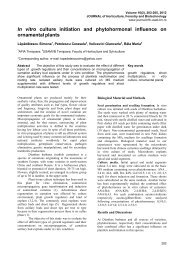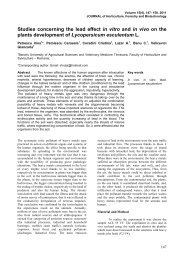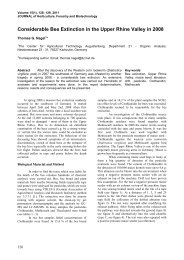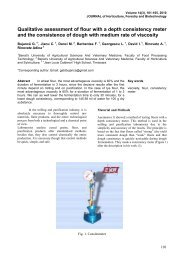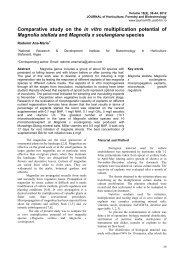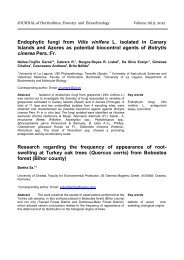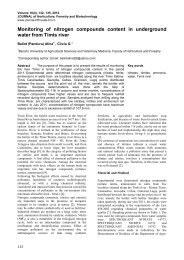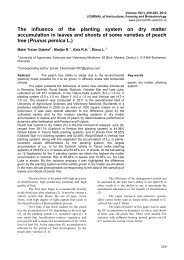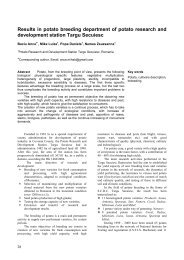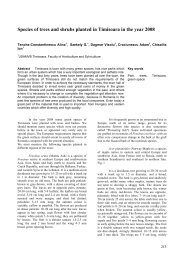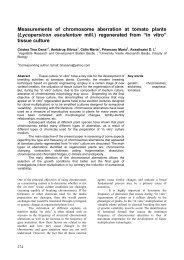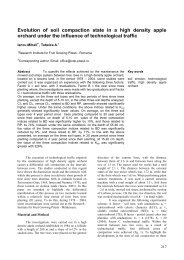The effect of some herbicides upon weeds from the sunflower culture
The effect of some herbicides upon weeds from the sunflower culture
The effect of some herbicides upon weeds from the sunflower culture
Create successful ePaper yourself
Turn your PDF publications into a flip-book with our unique Google optimized e-Paper software.
<strong>The</strong> <strong>effect</strong> <strong>of</strong> <strong>some</strong> <strong>herbicides</strong> <strong>upon</strong> <strong>weeds</strong> <strong>from</strong> <strong>the</strong> <strong>sunflower</strong><br />
<strong>culture</strong><br />
Bucurean Eva 1* , Sărac I. 2<br />
1 University <strong>of</strong> Oradea, <strong>The</strong> Faculty <strong>of</strong> Environment Protection, 2 University <strong>of</strong> Agricultural Science and<br />
Veterinary Medicine <strong>of</strong> Banat, Timişoara, <strong>The</strong> Faculty <strong>of</strong> Horti<strong>culture</strong><br />
*Corresponding author. Email: evabucurean08@yahoo.com<br />
Abstract <strong>The</strong> paper presents <strong>the</strong> experimental results obtained in <strong>the</strong><br />
year 2007 regarding <strong>the</strong> individual <strong>effect</strong> <strong>of</strong> five weed killers, used for <strong>the</strong><br />
control <strong>of</strong> <strong>weeds</strong> at <strong>the</strong> <strong>sunflower</strong>s crops, as well as that action in association<br />
with two o<strong>the</strong>r <strong>herbicides</strong>: Sencor applied in a quantity <strong>of</strong> o,4 kg/ha and<br />
Gesagrade 50 applied in a quantity <strong>of</strong> 3 kg/ha.<br />
As concerns <strong>the</strong> <strong>effect</strong> <strong>of</strong> <strong>the</strong> individual application <strong>of</strong> each weed<br />
killer, on <strong>the</strong> first place we can put Alachlor with an average production<br />
increase <strong>of</strong> 6,95 q/ha or by Treflan with an average production increase <strong>of</strong><br />
6,80 q/ha, or 33,0% as compared to <strong>the</strong> witness.<br />
<strong>The</strong> weed control by use <strong>of</strong> <strong>herbicides</strong>, is a very <strong>effect</strong>ive method, this way<br />
eliminating <strong>the</strong> hand hard work used for maintaining <strong>the</strong> growing.<br />
Key words<br />
herbicide,<br />
<strong>weeds</strong>,<br />
<strong>sunflower</strong>, individual <strong>effect</strong>,<br />
association, production,<br />
dosage<br />
<strong>The</strong> increase <strong>of</strong> <strong>the</strong> mechanization and<br />
amendments, <strong>the</strong> increase <strong>of</strong> <strong>the</strong> production potential <strong>of</strong><br />
<strong>the</strong> less productive soil, <strong>the</strong> application <strong>of</strong> <strong>the</strong><br />
<strong>herbicides</strong> and pesticide <strong>the</strong> use <strong>of</strong> new types with a<br />
higher biological value, all <strong>the</strong>se represent important<br />
factors for a permanent growth <strong>of</strong> <strong>the</strong> agricultural<br />
production.<br />
In <strong>the</strong> field <strong>of</strong> modern agri<strong>culture</strong>, capable <strong>of</strong><br />
economic efficiency, produced with a lower price and a<br />
higher productive level, toge<strong>the</strong>r with <strong>some</strong> o<strong>the</strong>r ways<br />
<strong>of</strong> billing <strong>the</strong> <strong>weeds</strong>, <strong>the</strong> <strong>herbicides</strong> play an important<br />
and irreplaceable part until now<br />
Taking into account <strong>the</strong> urgent necessity <strong>of</strong><br />
using <strong>the</strong> herbicide in controlling <strong>the</strong> <strong>weeds</strong> in <strong>the</strong><br />
agricultural crop, and on <strong>the</strong> o<strong>the</strong>r hand, <strong>the</strong> fact that<br />
<strong>the</strong>se are toxic substances; it is necessary for people to<br />
know well <strong>the</strong>ir properties <strong>the</strong> usage rules and <strong>the</strong> work<br />
security technique.<br />
Weeds chemical control is a main element in<br />
<strong>the</strong> modern technology <strong>of</strong> <strong>the</strong> <strong>sunflower</strong> growing<br />
which amplifies extremely quickly because <strong>of</strong> <strong>the</strong><br />
increase in number <strong>of</strong> <strong>the</strong> <strong>herbicides</strong> and <strong>the</strong>ir diversity<br />
as well as by <strong>the</strong> advance <strong>of</strong> <strong>the</strong> <strong>sunflower</strong> growing on<br />
larger and larger surfaces.<br />
Material and Method<br />
For <strong>the</strong> experiment <strong>of</strong> <strong>weeds</strong> control at <strong>the</strong><br />
<strong>sunflower</strong> growing by was <strong>of</strong> <strong>herbicides</strong>, taken in <strong>the</strong><br />
year 2007 in Oradea region, we followed <strong>the</strong> individual<br />
<strong>effect</strong> <strong>of</strong> 5 <strong>herbicides</strong>, as well as <strong>the</strong>ir action when<br />
associated to <strong>some</strong> o<strong>the</strong>r <strong>herbicides</strong>, Sencor applied in<br />
0,4 kg/ha dosage and Gesagrade 50 , 3 kg/ha.<br />
<strong>The</strong> variants studied as follows:<br />
No herbicide witness and twice hand hoeing<br />
Treflan 4l/ha<br />
Treflan + Sencor 4l/ha + 0,4kg/ha<br />
Treflan + Gesagrade 50 4l/ha + 3kg/ha<br />
Eradicane 4 l/ha<br />
Eradicane + Sencor 4l/ha + 0,4kg/ha<br />
Eradicane + Gesagrade 50 4l/ha + 3kg /ha<br />
Dual 500 4l/ha<br />
Dual 500 + Sencor 4l/ha + 0,4kg/ha<br />
Dual 500 + Gesagrade 50 4l/ha + 3kg/ha<br />
Alachlor 7l/ha<br />
Alachlor + Sencor 7l/ha + 0,4kg/ha<br />
Alachlor + Gesagrade 50 7l/ha + 3kg/ha<br />
Frontier 2l/ha<br />
Frontier + Sencor 2l/ha + 0,4kg/ha<br />
Frontier + Gesagrade 50 2l/ha + 3kg/ha<br />
<strong>The</strong> experiment was placed following <strong>the</strong><br />
method <strong>of</strong> randomized blocks, in 4 repetitions. <strong>The</strong><br />
hybrid used was select, which was sed on <strong>the</strong> 10 th <strong>of</strong><br />
April, with a thickness <strong>of</strong> 40.000 plants/ha and<br />
harvesting was made during <strong>the</strong> first decade <strong>of</strong><br />
September.<br />
<strong>The</strong> forerunner plant was <strong>the</strong> autumn barley.<br />
<strong>The</strong> preparing stage <strong>of</strong> <strong>the</strong> field for <strong>the</strong><br />
experiment comprised <strong>the</strong> following: autumn<br />
ploughing, preparing <strong>the</strong> germination bed starting up<br />
<strong>the</strong> growing <strong>of</strong> <strong>the</strong> plant, booking after <strong>the</strong> crops,<br />
harvesting.<br />
489
Results and Discussions<br />
<strong>The</strong> results obtained in 2007 are presented in<br />
table no 1, table no 2.<br />
<strong>The</strong> chemical control <strong>of</strong> <strong>the</strong> <strong>weeds</strong> represents<br />
a main element <strong>of</strong> <strong>the</strong> modern technology <strong>of</strong> <strong>sunflower</strong><br />
growing which increase rapidly, because <strong>of</strong> <strong>the</strong><br />
increase <strong>of</strong> <strong>the</strong> number <strong>of</strong> <strong>herbicides</strong> and <strong>the</strong>ir<br />
diversification, and <strong>the</strong> impetus that <strong>the</strong> <strong>sunflower</strong><br />
growing on larges surfaces has shown.<br />
For <strong>the</strong> actual experiment, in 2007, <strong>the</strong>re were<br />
used 5 <strong>herbicides</strong> Treflan, Eradicane, Dual, Alachlor<br />
and Frontier), as an individual <strong>effect</strong> and <strong>the</strong>ir action in<br />
association with Sencor and Gesagrade 50, a dosage <strong>of</strong><br />
0,4 kg/ha for Sencor and 3 kg/ha for Gesagrade 50. <strong>The</strong><br />
administration <strong>of</strong> <strong>the</strong> <strong>herbicides</strong> was made when<br />
preparing <strong>the</strong> germination bed.<br />
<strong>The</strong> research proved a high level <strong>of</strong><br />
phytotoxicity for <strong>the</strong> Sencor product with 0,4 kg/ha<br />
dosage, for all <strong>the</strong> variants <strong>the</strong> use <strong>of</strong> this herbicide<br />
produced <strong>the</strong> destruction <strong>of</strong> 70/ <strong>of</strong> <strong>the</strong> <strong>sunflower</strong> plants.<br />
It can also be noticed <strong>the</strong> phytotoxicity <strong>of</strong> <strong>the</strong><br />
Gesagrade 50 product, 3 kg/ha, in <strong>the</strong> year 2007. for<br />
<strong>the</strong> lots where Gesagrade 50 was used, <strong>the</strong> <strong>sunflower</strong><br />
plants were yellowish when beginning to grow. This<br />
phenomenon appeared more <strong>of</strong>ten at <strong>the</strong> lots treated<br />
with Dual 500+, Gesagrade 50 and Frontier +<br />
Gesagrade 50.<br />
As a result <strong>of</strong> <strong>the</strong> application <strong>of</strong> <strong>the</strong>se<br />
<strong>herbicides</strong>, <strong>the</strong> level <strong>of</strong> <strong>weeds</strong> turned very low, even<br />
succeeding a level <strong>of</strong> 96% weed controlling for <strong>some</strong><br />
lots. <strong>The</strong> use <strong>of</strong> Alachlor and Gesagrade 50 was <strong>the</strong><br />
most useful and <strong>the</strong> application <strong>of</strong> Treflan and<br />
Gesagrade 50 destroyed <strong>the</strong> <strong>weeds</strong> in a proportion <strong>of</strong><br />
93%.<br />
Taking into consideration <strong>the</strong> <strong>herbicides</strong> applied<br />
without anything else, <strong>the</strong> best <strong>effect</strong> was proved by<br />
Alachlor, followed by Treflan and Eradicane.<br />
Table no 1.<br />
<strong>The</strong> production <strong>of</strong> <strong>sunflower</strong>, with variants and repetitions, during <strong>the</strong> experiment with <strong>herbicides</strong> in 2007<br />
Variant<br />
Repetition<br />
I II III IV<br />
Average<br />
1. 22,0 21,5 21,0 21,6 86,1<br />
2. 27,2 27,0 27,5 27,3 109,0<br />
3. - - - - -<br />
4. 28,0 27,3 27,5 28,8 11,6<br />
5. 27,0 26,5 27,2 27,4 108,1<br />
6. - - - - -<br />
7. 28,0 27,0 27,4 28,0 110,4<br />
8. 26,0 26,0 25,0 26,2 103,2<br />
9. - - - - -<br />
10.. 26,9 26,5 26,0 27,0 106,4<br />
Average<br />
11. 29,0 29,0 28,0 28,7 114,7<br />
12. - - - - -<br />
13. 28,5 28,0 28,4 28,5 113,4<br />
14. 26,1 27,0 27,5 27,0 107,6<br />
15. - - - - -<br />
16. 26,0 26,5 25,8 26,3 104,6<br />
294,<br />
7<br />
292,3 291,3 296,8 1175,1<br />
<strong>The</strong> treatment with Dual 500 and Frontier<br />
showed a 75% higher degree <strong>of</strong> weed controlling. At<br />
this treatment, <strong>the</strong> production increase was smaller,<br />
that is 4,27 g/ha for Dual 500 and 5,36 g/ha for<br />
Frontier.<br />
With <strong>the</strong> exception <strong>of</strong> <strong>the</strong> variant treated with<br />
Sencor, all <strong>the</strong> o<strong>the</strong>r <strong>herbicides</strong> used, alone or mixed<br />
with Gesagrade 50, were <strong>effect</strong>ive for weed<br />
controlling and assured better crops than <strong>the</strong> witness<br />
variant which was hold twice, by hand.<br />
During vegetation, <strong>the</strong> variants treated with<br />
weed killers showed better development, quickly<br />
covering <strong>the</strong> soil after rising, not being disturbed by <strong>the</strong><br />
<strong>weeds</strong>.<br />
However, <strong>the</strong> behaviour <strong>of</strong> <strong>the</strong> <strong>weeds</strong> was<br />
different. In <strong>the</strong> experimental lots treated with Treflan,<br />
<strong>the</strong> following weed appeared. Rubus caesius<br />
(blackberry bush), Cirsium arvense (horse thistle),<br />
Cynodon dactylon (couch grass), Matricaria inodora<br />
(camomile) <strong>from</strong> <strong>the</strong> perennial plants and <strong>from</strong> <strong>the</strong><br />
yearly ones: Polygronum aviculare (knot grass),<br />
490
Amaranthus retr<strong>of</strong>lexus (amaranth), Sinapsis arvensis<br />
(wild mustard), Capsela bursa pastoris (sheperd`s<br />
purse), Viola arvensis (three spotted bro<strong>the</strong>rs),<br />
Xantium strumarium (mouse ear).<br />
For <strong>the</strong> lots treated with Eradicane <strong>the</strong>re were<br />
present <strong>the</strong> same <strong>weeds</strong> but <strong>some</strong> <strong>of</strong> <strong>the</strong>m were more<br />
numerous, especially <strong>the</strong> Cirsium arvense (horse<br />
thistle).<br />
For <strong>the</strong> lots treated with Dual 500 and frontier,<br />
all <strong>the</strong> types <strong>of</strong> <strong>weeds</strong> existing on <strong>the</strong> lots treated with<br />
Treflan appeared, but more frequently.<br />
<strong>The</strong> treatment with Alachlor proved <strong>the</strong> best<br />
<strong>effect</strong>. On <strong>the</strong>se lots, <strong>the</strong> <strong>weeds</strong> almost disappeared<br />
with <strong>the</strong> exception <strong>of</strong> Rubrus caesius, which was<br />
present with <strong>the</strong> same rate as in <strong>the</strong> lots treated with<br />
Sencor. <strong>The</strong> presence <strong>of</strong> <strong>weeds</strong> was very small, only<br />
Rubus caesius appeared, very late and in a very small<br />
percentage. On <strong>the</strong>se lots <strong>the</strong>re was also present <strong>the</strong><br />
phytotoxicity <strong>upon</strong> <strong>the</strong> <strong>sunflower</strong>, toge<strong>the</strong>r with <strong>the</strong> one<br />
<strong>upon</strong> <strong>the</strong> <strong>weeds</strong>, about 70% <strong>of</strong> <strong>the</strong> plants dying,<br />
compromising <strong>the</strong> growing.<br />
<strong>The</strong> production results obtained for <strong>the</strong> <strong>sunflower</strong> in <strong>the</strong> experiment with <strong>herbicides</strong>,<br />
applied alone and in association, in <strong>the</strong> year 2007<br />
Table no 2<br />
No<br />
.<br />
Herbicides applied<br />
1. Witness with no<br />
herbicide<br />
Herbicide<br />
dosage<br />
applied per ha<br />
Application<br />
<strong>of</strong> two hocing<br />
by hand<br />
Production(<br />
q/ha)<br />
% Difference<br />
.(q/ha)<br />
Significanc<br />
e<br />
Phytot<br />
oxicity<br />
(%)<br />
Degree<br />
<strong>of</strong> weed<br />
control<br />
(%)<br />
20,6 100 - - - -<br />
2. Treflan 4 l 27,40 133,0 6,80 xxx - 85<br />
3. Treflan + Sencor 4 l+0,4 kg - - - - 70 98<br />
4. Treflan + 4l + 3 kg 27,95 135,7 7,35 xxx - 94<br />
Gesagrade 50<br />
5. Eradicane 4 l 26,10 126,7 5,50 xxx - 80<br />
6. Eradicane + 4 l + 0,4 kg - - - - 70 98<br />
Sencor<br />
7. Eradicane + 4 l + 3 kg 26,70 129,6 6,10 xxx - 90<br />
Gesagrade 50<br />
8. Dual 500 4 l 25,30 155,8 4,70 xxx - 73<br />
9. Dual 500 + Sencor 4 l + 0,4 kg - - - - 70 98<br />
10. Dual 500 + 4 l + 3 kg<br />
127,7 5,70 xxx - 86<br />
Gesagrade 50<br />
26,30<br />
11. Alachlor 7 l 27,55 133,7 6,95 xxx - 86<br />
12. Alachlor + Sencor 7 l + 0,4 kg - - - - 70 98<br />
13. Alachlor + 7 l +3 kg 27,90 135,4 7,30 xxx - 94<br />
Gesagrade<br />
14. Frontier 2 l 25,80 125,2 5,20 xxx - 77<br />
15. Frontier + Sencor 2 l + 0,4 kg - - - - 70 98<br />
16. Frontier + 2 l + 3 kg 26,4 126,4 5,44 xxx - 86<br />
Gesagrade 50<br />
Average 26,15<br />
Difference 5,55<br />
% 126,9<br />
Significance<br />
xxx<br />
DL 5% = 0,45 q/ha DL 1% = 0,62 q/ha DL 0,1% = 0,83 q/ha<br />
Analyzing <strong>the</strong> data in Table no.2, it can be<br />
noticed that <strong>the</strong> variant treated with Alachlor, 7 l/ha<br />
dosage <strong>of</strong> commercial product gave <strong>the</strong> biggest<br />
production <strong>of</strong> <strong>sunflower</strong> 28, 67 g/ha with an extra<br />
quantity <strong>of</strong> 7,41 g/ha, that is 33,1% more than<br />
<strong>herbicides</strong> but it was treated as usual, with two hoeing<br />
by hand.<br />
<strong>The</strong> second in terms <strong>of</strong> production quantity is<br />
<strong>the</strong> variant treated with Alachlor + Gesagrade 50, 7 l/ha<br />
+ 3 kg/ha, obtaining 28,35 g/ha, and compared to <strong>the</strong><br />
witness representing a bigger quantity with an extra <strong>of</strong><br />
31,6%, that is 6,82 g/ha.<br />
<strong>The</strong> result is that, by combining Alachlor with<br />
<strong>the</strong> second, herbicide Gesagrade 50, <strong>the</strong> production<br />
does not increase, compared to <strong>the</strong> production<br />
obtained, only at <strong>the</strong> treatment with Alachlor, but it<br />
decreases with 0,32 g/ha.<br />
On <strong>the</strong> lots treated with Alachlor combined<br />
with Gesagreade 50, applied 7 l/ha + 3 kg/ha a dosage,<br />
even if <strong>the</strong>re were few <strong>weeds</strong> <strong>the</strong> degree <strong>of</strong> weed<br />
destruction going up to 96% related to a smaller<br />
production, and a phytotoxic <strong>effect</strong> appeared at <strong>the</strong><br />
<strong>sunflower</strong> plants, because <strong>of</strong> <strong>the</strong> Gesagrade 50, 3 kg/ha<br />
dosage, for <strong>the</strong> conditions <strong>of</strong> <strong>the</strong> year 2004.<br />
491
<strong>The</strong> variant treated with Treflan 4 l/ha dosage,<br />
produced an average <strong>sunflower</strong> crops <strong>of</strong> 27,24 g/ha<br />
seeds, this representing a percentage <strong>of</strong> 26,5%, or an<br />
extra quantity <strong>of</strong> 26,5%, or compared to <strong>the</strong> witness<br />
variant.<br />
For <strong>the</strong> variant treated with Treflan combined<br />
with Gesagrade 50, 4l/ha and 3 kg/ha a dosage, <strong>the</strong><br />
production was 27,90 g/ha, with an extra quantity <strong>of</strong><br />
6,37 g/ha, that is 29,6% more than <strong>the</strong> witness variant.<br />
<strong>The</strong> increase benefit <strong>of</strong> <strong>the</strong> production for <strong>the</strong><br />
variant treated with Treflan combined with Gesagrade<br />
50, compared to <strong>the</strong> one treated only with Treflan, is<br />
0,66 g/ha <strong>sunflower</strong> seeds. <strong>The</strong>se results make us<br />
notice that <strong>the</strong> efficiency <strong>of</strong> Gesagrade 50 3 kg/ha<br />
dosage combined with Treflan is not so high, even if<br />
<strong>the</strong> degree <strong>of</strong> weed control is 93%, following <strong>the</strong> lots<br />
treated with Alachlor + Gesagrade 50, where <strong>the</strong> weed<br />
control was 96%.<br />
Analyzing <strong>the</strong> next part <strong>of</strong> Table no.2 it can be<br />
noticed that <strong>the</strong> Eradicane product shows a good<br />
behaviour in weed controlling for <strong>sunflower</strong> growing.<br />
For <strong>the</strong> lots treated with Eradicane 4 l/ha a dosage <strong>the</strong><br />
average production was 27,03 g/ha, that is an extra<br />
quantity o 5,50 g/ha seeds, 25,5% more than <strong>the</strong> one <strong>of</strong><br />
<strong>the</strong> witness.<br />
When Eradicane is mixed with Gesagrade 50,<br />
4 l/ha + 3 kg/ha a dosage, <strong>the</strong> average production was<br />
27,6 g/ha, representing an extra quantity <strong>of</strong> 6,07 g/ha or<br />
28,1% compared to <strong>the</strong> witness.<br />
<strong>The</strong> increase benefit <strong>of</strong> <strong>the</strong> production<br />
obtained for <strong>the</strong> variant treated with Eradicane mixed<br />
with Gesagrade 50 compared to <strong>the</strong> one treated only<br />
with Eradicane, is only 0,57 g/ha <strong>sunflower</strong> seeds. As<br />
concerns <strong>the</strong> weed controlling level, this combination<br />
<strong>of</strong> Eradicane and Gesagrade 50 destroyed 90% <strong>of</strong> <strong>the</strong><br />
<strong>weeds</strong> compared to 80% <strong>of</strong> <strong>the</strong>m, when only Eradicane<br />
was used.<br />
<strong>The</strong> treatment with Dual 500 and Frontier<br />
gave smaller production <strong>of</strong> <strong>sunflower</strong> an a hectare, but,<br />
compared to <strong>the</strong> witness, <strong>the</strong> production is good.<br />
<strong>The</strong> results presented above prove that, in case<br />
<strong>the</strong> herbicide chose can not be found it is better to use<br />
any <strong>of</strong> <strong>the</strong> analyzed herbicide than to have <strong>the</strong> soil with<br />
no weed killer or work it by hand or mechanically.<br />
Conclusions<br />
Following <strong>the</strong> examination and <strong>the</strong> data<br />
obtained, concerning <strong>the</strong> efficiency <strong>of</strong> <strong>the</strong> 5 <strong>herbicides</strong><br />
used, for weed controlling at <strong>the</strong> <strong>sunflower</strong> growing,<br />
applied alone and in combination with Sencor 0,4<br />
kg/ha a dosage and Gesagrade 50 3 kg/ha a dosage<br />
<strong>the</strong>re can be pointed out <strong>the</strong> following conclusions:<br />
- <strong>the</strong> chemical weed control is a main<br />
element in <strong>the</strong> technology <strong>of</strong> <strong>sunflower</strong> growing,<br />
assuring an average production increase <strong>of</strong> 5,5 g/ha,<br />
that is 26,9 %;<br />
- <strong>the</strong> efficiency <strong>of</strong> <strong>the</strong> Treflan, Alachlor,<br />
Eradicane, Dual 500 and Frontier combined with<br />
Gesagrade 50 is more secure and higher, because it<br />
assures <strong>the</strong> highest increase <strong>of</strong> production per hectare;<br />
- out <strong>of</strong> <strong>the</strong> <strong>herbicides</strong> applied in<br />
combination, it can be remarked <strong>the</strong> Treflan variant<br />
applied 4 l/ha + Gesagrade 50 3 kg/ha a dosage<br />
- out <strong>of</strong> <strong>the</strong> <strong>herbicides</strong> applied alone, it can be<br />
remarked <strong>the</strong> very good <strong>effect</strong> <strong>of</strong> <strong>the</strong> Alachlor with an<br />
average production increase <strong>of</strong> 6,95 g/ha, that is 33,7%<br />
compared to <strong>the</strong> witness, followed by <strong>the</strong> Treflan, with<br />
an average production increase <strong>of</strong> 6,80 g/ha and 33,0%<br />
compared to <strong>the</strong> witness;<br />
- <strong>the</strong> Sencor weed killer, applied 0,4 kg/ha a<br />
dosage, combined with <strong>the</strong> o<strong>the</strong>r <strong>herbicides</strong> (Treflan,<br />
Eradicane, Dual 500, Alachlor and Frotier) succeeds a<br />
98% weed controlling percentage but it also presents<br />
70% phytotoxicity <strong>upon</strong> <strong>the</strong> <strong>sunflower</strong> plants;<br />
- <strong>herbicides</strong> weed control is a very efficient<br />
method <strong>the</strong> level <strong>of</strong> weed controlling using herbicide is<br />
expanded between 73 – 96%, so that <strong>the</strong> <strong>sunflower</strong><br />
growing can became fully mechanized, excluding <strong>the</strong><br />
high quantity <strong>of</strong> effort for maintaining <strong>the</strong> crops by<br />
hand hoeing.<br />
References<br />
1. Berca M., 1996 – Combaterea buruienilor din<br />
culturile agricole, Ed. Fermierul Român,<br />
Bucureşti;<br />
2. Berca M., 2004 – Managementul integrat al<br />
buruienilor, Ed. ceres, Bucureşti;<br />
3. Borcean,I., BORCEAN, A., 2004 - Cultura şi<br />
protecţia integrată a cerealelor, leguminoselor şi<br />
plantelor tehnice, Ed. de Vest, Timişoara;<br />
4. Lăzureanu A., 1992 – Agrotehnică, Ed. Helicon,<br />
Timişoara;<br />
5. Muntean, L.S. şi colab., 2001 - Fitotehnie, Ed.<br />
I.I.de la Brad, Iaşi.<br />
6. Pârşan, P. 2003 - Tehnologia plantelor de câmp,<br />
Ed.Agroprint, Timişoara;<br />
7. Pop Georgeta, 2003 - Tehnologia culturii<br />
plantelor de câmp, Ed. Avgusta, Timişoara;<br />
492



